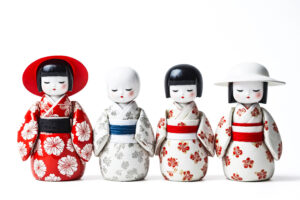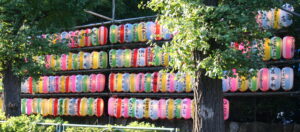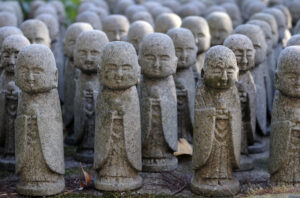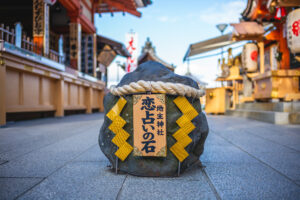In the serene landscapes of Japan, where art and nature harmoniously coexist, the shishi-odoshi stands out as both a functional device and an emblem of cultural significance. This bamboo water device, traditionally designed to deter wildlife from gardens, embodies centuries of craftsmanship and philosophy. As we explore the multifaceted nature of shishi-odoshi, we delve into its historical roots, artistic crafting, and its integral role in Japanese gardens, offering insight into its unique charm and enduring legacy.
Understanding Shishi-odoshi: A Unique Japanese Artifact
The shishi-odoshi, or "deer scarer," is a traditional Japanese device made primarily from bamboo. Its primary function is to create a rhythmic sound that deters wild animals, particularly deer, from entering gardens. Constructed from a hollow bamboo tube set at an angle, it fills with water and tips over, producing a distinctive clattering noise as it strikes a wooden post. This simple yet effective mechanism draws on natural elements, resonating with the philosophy of using nature as a means to manage it.
While the shishi-odoshi is often associated with serene Japanese gardens, it has evolved into a symbol of tranquility and reflection. Its design encapsulates the principles of minimalism and functionality that characterize much of Japanese aesthetics. As an artifact, the shishi-odoshi serves as a striking reminder of the delicate balance between humanity and nature, reflecting a deep respect for the environment that permeates Japanese culture.
The device’s appeal extends beyond its practicality; it is an object of beauty in its own right. The graceful lines of bamboo, coupled with the rhythmic sound it produces, create a meditative atmosphere often sought in outdoor spaces. As such, shishi-odoshi has become more than just a tool—it’s a focal point of artistic expression within the garden landscape.
In contemporary settings, the shishi-odoshi has gained popularity not only as a garden feature but also as an art piece, symbolizing a connection to nature. Its integration in various spaces reflects a growing interest in naturalistic design and the preservation of traditional crafts. As society increasingly values sustainability and eco-friendliness, the shishi-odoshi remains a poignant reminder of the wisdom held within traditional practices.
The shishi-odoshi serves as an enduring testament to the synergy between functionality and aesthetics in Japanese culture. Its ability to blend utility with beauty makes it a fascinating subject for both historians and garden enthusiasts alike. As more people seek to create harmonious outdoor spaces, understanding the significance of the shishi-odoshi becomes more relevant than ever.
Ultimately, the shishi-odoshi is not merely a device; it embodies a philosophy of living in accordance with nature, a cornerstone of traditional Japanese thought. Through its continued presence in gardens and modern design, it invites reflection on our relationship with the natural world.
The Historical Roots of the Shishi-odoshi Device
The origins of the shishi-odoshi can be traced back to ancient Japan, where agricultural practices were deeply intertwined with the natural environment. Early farmers faced challenges in protecting their crops from wildlife, particularly deer, which posed a significant threat to their harvests. The need for an effective deterrent led to the invention of the shishi-odoshi, which utilized readily available bamboo to create a simple yet ingenious solution.
Historically, shishi-odoshi devices were implemented in rice paddies and gardens across Japan, reflecting the agricultural heart of the nation. Over the centuries, as Japanese society evolved, so did the design and purpose of the shishi-odoshi. It transitioned from a purely functional device to a more ornamental element in gardens, signifying a shift in how nature was perceived and interacted with.
The early usage of bamboo in constructing the shishi-odoshi highlighted the Japanese cultural practice of using natural materials in daily life. Bamboo, revered for its strength and flexibility, became synonymous with the artistry of Japanese craftsmanship. As the shishi-odoshi emerged as a garden feature, it began to symbolize both a connection to nature and an adherence to traditional values.
During the Edo period (1603-1868), the aesthetic appreciation for gardens flourished, leading to the integration of shishi-odoshi into the design of tea gardens and stroll gardens. It was in these spaces that the device gained recognition not only for its functionality but also for its sound and visual appeal. The shishi-odoshi became an integral part of the sensory experience offered by these gardens, contributing to the meditative quality that defines them.
The historical significance of shishi-odoshi extends beyond its practical use; it mirrors societal changes in Japan and the evolving relationship between people and their environment. As urbanization intensified in the 20th century, traditional practices began to wane, yet the shishi-odoshi persisted as a symbol of cultural heritage, preserving the connection to the past in an increasingly modern world.
Today, the shishi-odoshi is celebrated not only for its historical roots but also for how it encapsulates the essence of Japanese garden design, bridging the gap between nature and human artistry. As gardeners and designers seek to create spaces that reflect a deep respect for the environment, the shishi-odoshi continues to inspire and inform contemporary practices.
Craftsmanship: The Artistry Behind Bamboo Water Devices
The craftsmanship involved in creating a shishi-odoshi is a testament to the skill and dedication of artisans who have preserved this tradition over generations. Constructed primarily from bamboo, the device showcases the innate beauty of this versatile material. Each piece is hand-selected for its unique characteristics, with artisans often choosing bamboo that is straight and hollow, ensuring optimal functionality and aesthetic appeal.
The process of crafting a shishi-odoshi requires precision and an understanding of both the material and mechanics. Artisans begin by cutting the bamboo into appropriate lengths and shaping it to create the tipping mechanism. This involves careful consideration of the angle at which the bamboo tube will sit, as it must fill with water before tipping to produce the desired sound. The craftsmanship lies not only in the construction but also in achieving a balance between form and function.
Many artisans adhere to traditional techniques passed down through generations, infusing their work with cultural significance. The meticulous nature of bamboo crafting requires a deep knowledge of the material, as well as an appreciation for the natural properties that make bamboo ideal for this purpose. Each shishi-odoshi is unique, often reflecting the personal style and philosophy of the artisan.
In addition to bamboo, other materials such as wood and stone may be incorporated into the design. The combination of these natural elements enhances the overall aesthetic, creating a harmonious piece that integrates seamlessly into the garden environment. This artistry elevates the shishi-odoshi from a simple device to a work of art that embodies the spirit of Japanese craftsmanship.
The creation of shishi-odoshi devices is often a labor of love that requires not only technical skills but also an understanding of the cultural context in which they exist. Many artisans view their work as a way to honor tradition and connect with nature, resulting in pieces that resonate with the values of simplicity and harmony. This commitment to craftsmanship is what makes each shishi-odoshi a cherished artifact, inviting admiration from those who encounter it.
As the demand for handmade, artisanal products continues to rise, the shishi-odoshi represents a revival of interest in traditional craftsmanship. Individuals increasingly seek unique, meaningful pieces for their gardens, appreciating the story and skill behind each handcrafted shishi-odoshi. The dedication of artisans ensures that this ancient craft not only survives but thrives in the modern world.
How Shishi-odoshi Functions: Mechanisms Explained
The mechanics of the shishi-odoshi are deceptively simple yet ingeniously effective. At its core, the device consists of a bamboo tube, a pivot point, and a receptacle for water. The bamboo tube is typically cut to a length of about one meter and is positioned at an angle. As water fills the tube from a connected source, it ultimately reaches a tipping point, causing the tube to exceed its balance.
This tipping action is what generates the characteristic sound of the shishi-odoshi. As the bamboo tube tilts, it empties its contents into a small basin or directly onto the ground, creating a percussive noise as it strikes a wooden post or another hard surface. The rhythmic clattering produced by this motion serves both as a deterrent to wildlife and as a captivating element of the garden’s ambiance.
Water sources for shishi-odoshi can vary; some are connected to a natural stream or pond, while others rely on a manual filling process. In traditional settings, the continuous flow of water helps maintain the device’s functionality, allowing it to perform its duty as a wildlife deterrent effectively. This interplay of water and bamboo creates a dynamic experience, showcasing the relationship between natural elements.
The design of the shishi-odoshi also allows for adjustments to alter the sound’s intensity and frequency. By modifying the bamboo tube’s length or the angle at which it is positioned, gardeners can tailor the device to better suit their specific environment. This adaptability enhances its functionality, ensuring that it remains effective regardless of the surrounding conditions.
The simplicity of the shishi-odoshi’s design belies its sophistication. It exemplifies the Japanese philosophy of "wabi-sabi," which celebrates the beauty of imperfection and the natural flow of life. The rhythmic sound produced by the shishi-odoshi becomes a part of the garden’s atmosphere, encouraging reflection and a deeper connection to the surrounding environment.
In essence, the shishi-odoshi operates as a harmonious blend of natural elements and mechanical ingenuity. Its function is less about the deterrence of wildlife and more about creating an immersive experience that resonates with visitors. As such, it stands as a testament to the beauty of simplicity and the profound impact of thoughtful design.
The Role of Shishi-odoshi in Japanese Gardens
Within Japanese gardens, the shishi-odoshi occupies a unique and essential role, contributing to the overall atmosphere and ecological balance of these serene spaces. Traditionally, gardens in Japan have been designed to reflect the beauty of nature, creating a space for contemplation and harmony. The shishi-odoshi enhances this experience by introducing sound and movement that engage the senses.
As a functional device, the shishi-odoshi serves to protect gardens from wildlife, particularly deer that may seek out tender plants and flowers. Its rhythmic clattering acts as a natural deterrent, allowing delicate flora to flourish without the threat of herbivorous intruders. In this way, the device supports the garden’s ecological balance, fostering a thriving environment for both plants and wildlife.
Moreover, the inclusion of shishi-odoshi in garden design reflects a deep understanding of the relationship between nature and human artistry. It embodies the principles of sustainability, as it relies on renewable materials—primarily bamboo—and integrates seamlessly into the landscape. The presence of the device encourages gardeners to consider their impact on the environment, promoting a mindful approach to cultivation.
Beyond its practicality, the shishi-odoshi adds a layer of meaning to Japanese gardens. It is often associated with concepts of protection and tranquility, aligning with the philosophical underpinnings of Zen gardens. The sound of the device creates a calming atmosphere, inviting visitors to pause and reflect amidst the beauty of their surroundings. In this way, the shishi-odoshi becomes a focal point for contemplation and a symbol of the garden’s intent.
The placement of shishi-odoshi within the garden is also significant. Strategically positioned near paths or water features, it serves to guide visitors through the space, creating a sense of movement and rhythm. This thoughtful arrangement highlights the importance of balance in garden design, ensuring that each element complements the others while enhancing the overall experience.
Ultimately, the shishi-odoshi plays a vital role in shaping the essence of Japanese gardens. Its dual function as a wildlife deterrent and an aesthetic enhancement exemplifies the harmony between utility and beauty that defines these serene spaces. As visitors experience the gentle sounds of the shishi-odoshi, they are reminded of the delicate interplay between nature and humanity—a core tenet of Japanese philosophy.
Cultural Significance: Beyond Aesthetic Appeal
The cultural significance of the shishi-odoshi extends far beyond its aesthetic appeal and practical function. It embodies core values of Japanese culture, such as harmony, respect for nature, and mindfulness. These principles are intricately woven into the fabric of daily life in Japan, influencing everything from art and design to traditional practices.
Historically, the shishi-odoshi emerged from a society that deeply revered nature and sought to coexist with it rather than dominate it. This philosophy is reflected in the simplicity and elegance of the device, which serves as a reminder of the importance of sustainable living. In a world increasingly disconnected from nature, the shishi-odoshi stands as a beacon of what it means to live in harmony with one’s surroundings.
The sound produced by the shishi-odoshi also has cultural resonance. In Japanese traditions, sound plays a vital role in spiritual and meditative practices. The rhythmic clattering of the device evokes a sense of peace, allowing individuals to connect with their environment on a deeper level. This relationship between sound and spirituality is a recurring theme in Japanese culture, further enhancing the significance of the shishi-odoshi.
In addition to its spiritual implications, the shishi-odoshi has become a symbol of Japanese craftsmanship and artistry. The meticulous process of creating these devices showcases the skill and dedication of artisans, preserving traditional techniques that have been passed down through generations. In this way, the shishi-odoshi serves as a tangible representation of cultural heritage, inviting appreciation for both its beauty and historical context.
Furthermore, the shishi-odoshi has found its place in contemporary Japanese culture as a symbol of nostalgia and reflection. As urbanization continues to reshape landscapes, many individuals seek to reconnect with their cultural roots. The presence of shishi-odoshi in modern gardens serves as a gentle reminder of the past, allowing individuals to honor their heritage while embracing the future.
Ultimately, the shishi-odoshi transcends its role as a mere garden device; it encapsulates a philosophy that values harmony, sustainability, and mindfulness. As society navigates the complexities of modern life, the lessons embedded within the shishi-odoshi become increasingly relevant, promoting a deeper understanding of our relationship with nature and each other.
The Sounds of Nature: The Musical Aspect of Shishi-odoshi
One of the most enchanting features of the shishi-odoshi is the unique sound it produces, which resonates throughout the garden and adds to the overall ambiance. This auditory element transforms the device into a musical instrument of sorts, creating a rhythmic percussion that engages the senses and invites contemplation. The sound is often described as a gentle clattering or tapping, evoking the natural world and enhancing the garden’s tranquil atmosphere.
The sound of the shishi-odoshi is not just a byproduct of its mechanical motion; it is an integral part of its design and purpose. The rhythmic nature of the noise can vary depending on the size and angle of the bamboo tube, the amount of water it holds, and the surface it strikes. Gardeners can manipulate these variables to create their desired soundscape, making each shishi-odoshi a unique experience in auditory aesthetics.
In Japanese culture, sound is closely linked to spiritual and meditative practices. The soothing sounds produced by the shishi-odoshi align with the principles of Zen Buddhism, which emphasizes mindfulness and connection to the present moment. As visitors encounter the gentle clattering, they are encouraged to pause, reflect, and immerse themselves in the beauty of their surroundings.
The musical aspect of the shishi-odoshi also fosters a deeper appreciation for the sounds of nature. In a world increasingly dominated by artificial noise, the rhythmic clattering of the shishi-odoshi serves as a reminder of the simplicity and beauty found in natural sounds. It encourages individuals to listen more closely to their environment, fostering a connection with the natural world that is often overlooked.
In addition to its role in personal reflection, the sound of the shishi-odoshi can enhance social interactions within the garden. As friends and family gather, the gentle clattering provides a backdrop for conversation, creating a harmonious atmosphere that promotes connection and enjoyment. This interplay between sound and social engagement exemplifies the communal aspect of Japanese gardens, where nature serves as a catalyst for relationships.
Ultimately, the shishi-odoshi’s musical qualities make it a vital component of the garden experience. By connecting visitors with the natural sounds of their environment, it invites a sense of peace and mindfulness that resonates with the core values of Japanese culture. The rhythmic clattering becomes a melody of nature—an artful reminder of the beauty that exists in simplicity.
Shishi-odoshi and Wildlife: A Practical Purpose
While the shishi-odoshi is celebrated for its aesthetic and cultural significance, its practical purpose as a wildlife deterrent is equally important. Designed to protect gardens from hungry deer and other animals, the device serves a critical role in maintaining the health and vibrancy of cultivated spaces. As urban development encroaches on natural habitats, the need for effective wildlife management has become increasingly pertinent.
The primary function of shishi-odoshi is to produce a sound that startles wildlife, discouraging them from venturing into gardens where their presence could cause significant damage. The rhythmic clapping noise, generated by the tipping bamboo, mimics the sounds of natural predators, creating an auditory barrier that keeps curious animals at bay. This ingenious design highlights the intersection of functionality and beauty in Japanese garden design.
In addition to deterring deer, the shishi-odoshi can help manage other wildlife populations, including rabbits and birds. By creating an environment that is less appealing to these animals, gardeners can promote the growth of plants that might otherwise be at risk. This balance between cultivation and wildlife protection underscores the importance of understanding the ecosystem when designing garden spaces.
The shishi-odoshi’s effectiveness is particularly notable in rural and semi-rural areas, where wildlife interaction is more common. As gardeners strive to create flourishing landscapes, the device provides a low-tech, sustainable solution to wildlife management. Its reliance on natural materials and mechanics aligns with contemporary values of environmental responsibility and sustainability.
Moreover, the presence of shishi-odoshi in gardens fosters an awareness of the delicate balance between humans and wildlife. By recognizing the role of this device in protecting cultivated spaces, gardeners are encouraged to consider broader ecological impacts, promoting a more holistic approach to gardening and land stewardship. This mindfulness extends beyond the garden, reminding individuals of the interconnectedness of all living things.
In essence, the shishi-odoshi serves a dual purpose: it protects the beauty of Japanese gardens while honoring the natural world. By deterring wildlife and promoting plant health, this traditional device exemplifies the harmony that can be achieved when human ingenuity and respect for nature are thoughtfully combined.
Modern Interpretations of Traditional Shishi-odoshi
As the world evolves, so too does the interpretation of traditional practices like the shishi-odoshi. In contemporary settings, designers and gardeners are reimagining the classic bamboo water device, infusing it with modern aesthetics and functionality. This revival reflects a growing interest in sustainable design and ecological harmony, merging the old with the new in innovative ways.
Modern adaptations of shishi-odoshi often incorporate a variety of materials beyond traditional bamboo. Artisans are experimenting with metals, ceramics, and other natural substances, creating pieces that resonate with contemporary design sensibilities while maintaining the essence of the original device. These interpretations allow the shishi-odoshi to find its place in a broader range of settings, from urban gardens to modern landscape architecture.
Technological advancements have also influenced the design of shishi-odoshi. Some modern versions incorporate automated systems that regulate water flow and sound production, making them more efficient and user-friendly. This marriage of tradition and technology enables gardeners to enjoy the beauty and functionality of the device without the labor-intensive maintenance that older models may require.
The aesthetic appeal of shishi-odoshi has led to its incorporation in various design contexts beyond traditional








